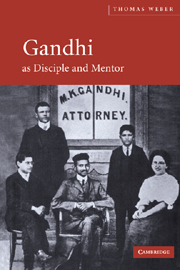Book contents
- Frontmatter
- Contents
- Notes
- Preface
- Glossary
- PART I INFLUENCE
- PART II GANDHI INFLUENCED
- PART III GANDHI'S INFLUENCE
- 8 The influential Gandhi
- 9 Arne Næss – the ecological movement finds depth
- 10 Johan Galtung – peace research moves beyond war
- 11 E. F. Schumacher – economics as if people mattered
- 12 Gene Sharp – nonviolence becomes a political method
- 13 The bottom of the hourglass: Gandhi's influence
- Bibliography
- Index
12 - Gene Sharp – nonviolence becomes a political method
Published online by Cambridge University Press: 22 September 2009
- Frontmatter
- Contents
- Notes
- Preface
- Glossary
- PART I INFLUENCE
- PART II GANDHI INFLUENCED
- PART III GANDHI'S INFLUENCE
- 8 The influential Gandhi
- 9 Arne Næss – the ecological movement finds depth
- 10 Johan Galtung – peace research moves beyond war
- 11 E. F. Schumacher – economics as if people mattered
- 12 Gene Sharp – nonviolence becomes a political method
- 13 The bottom of the hourglass: Gandhi's influence
- Bibliography
- Index
Summary
INTRODUCTION
For those interested in nonviolence theory, the politics of nonviolent activism, the ethics of civil disobedience or people-power social movements, or indeed for those who are activists and go to training workshops, look for inspiration or want help in selecting appropriate tactics, Gene Sharp is usually the starting point. Through his near definitive work The Politics of Nonviolent Action, Sharp provides the theory and examples which form the basis of countless political actions, pre-action nonviolence training workshops, and academic studies of nonviolent political activism.
Gene Sharp is an internationally known scholar whose works on nonviolent direct action and civilian-based defence have been translated into almost thirty languages and even used by government defence planners in Estonia, Latvia and Lithuania in formulating strategies to ensure that the Soviet Union did not regain control over the newly independent states. Besides his deserved reputation in nonviolent activist circles, based on The Politics of Nonviolent Action, he has also been portrayed as the ‘Machiavelli of nonviolence’ because of his pragmatic approach to nonviolent activism, and been hailed as the ‘Clausewitz of nonviolent warfare’ for his writings on nonviolent defence and people power.
In his major area of work, Gene Sharp was perhaps even more singularly influenced by Gandhi than were Næss, Galtung and Schumacher yet, unlike them, he has spent a good deal of his later intellectual life trying to distance himself from his source of inspiration.
- Type
- Chapter
- Information
- Gandhi as Disciple and Mentor , pp. 232 - 246Publisher: Cambridge University PressPrint publication year: 2004

